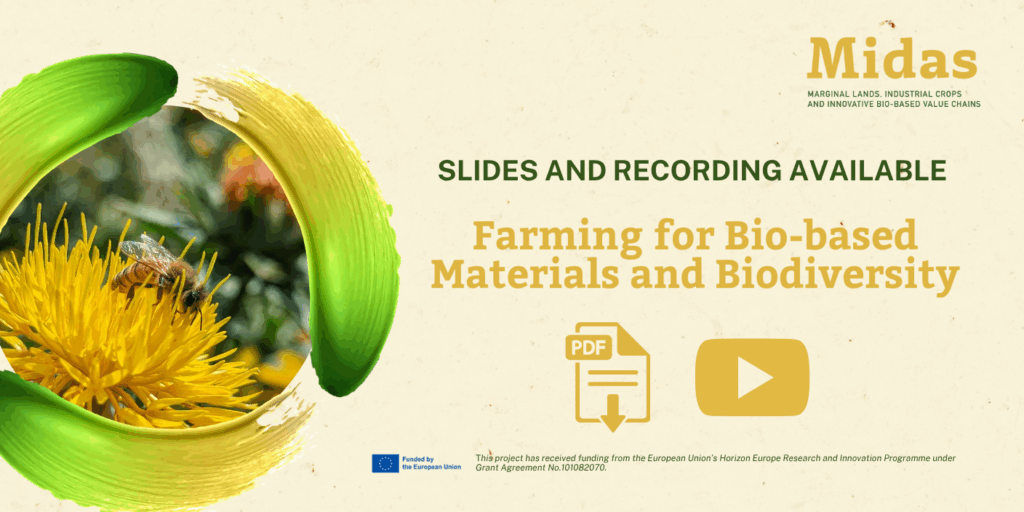
Last week MIDAS project held its first webinar titled Farming for Bio-based Materials and Biodiversity, here are the main takeaways:
🔍 Understanding Marginal Lands: A Shifting European Landscape
Berien Elbersen – Wageningen University and Research, unveiled the latest MIDAS project findings on the extent of marginal lands across the EU+ UK (and Serbia).
- Current State: In 2020, over 74 million hectares (roughly 32% of the agricultural area) were identified as marginal, with limitations in rooting, excessive wetness, and adverse climate being the most dominant factors.
- Future Projections (2050): Climate change is set to redraw this map. While a slight overall decrease in marginal land is predicted Europe-wide, the regional shifts are significant.
- Northern, Atlantic, and Alpine regions are expected to see a decrease in marginality, mainly due to longer growing seasons.
- The Mediterranean region is projected to face a 6.6% increase in marginal land due to worsening climatic conditions and declining soil fertility.
💡 Cultivating Solutions: Innovative Cropping Systems in Action
Efthymya Alexopoulou – Centre for Renewable Energy Sources Greece showcased how the MIDAS project is turning these challenges into opportunities. The project is developing and testing innovative, low-impact cropping systems specifically designed for these environments.
- Field-Scale Testing: MIDAS has established 16 case studies across 9 European countries, implementing intercropping and agroforestry systems at a farm scale.
- Diverse Industrial Crops: These systems cultivate a range of non-edible crops like safflower, crambe, miscanthus, guayule, and poplar, providing sustainable feedstock for bio-based products.
- Practical Learnings: By the end of this year we will have a full data set of field data including the rotation of the annual crops and the yields for the perennial crops.
This on-farm research is vital for creating resilient agricultural models applicable to marginal land, particularly in the regions of Southern Europe.A co-creation approach with farmers group has been established for each case study to provide a consulting role and ground the research in practical reality.
🦋 Boosting Biodiversity: How Farming Systems Impact Ecosystems
Jenny Lazebnik Wageningen University and Research presented compelling evidence on the biodiversity benefits of these cropping systems, focusing on insect populations—key indicators of ecosystem health.
- Connecting farming and biodiversity: Diversifying crops on marginal landscapes helps embed biodiversity into farming.
- Strip Intercropping Works:by creating a mosaic of microhabitats, crop diversification through strip intercropping can support a broader range of insects, including pollinators and natural pest controllers.
- No One-Size-Fits-All approach: Marginal lands offer opportunities to link biodiversity goals with bio-based crop production. Each region possesses a unique insect community, underscoring the need for tailored, locally-adapted biodiversity strategies rather than a single European approach.
🗣️ Expert Panel Discussion: Bridging Science, Policy, and Practice
The webinar concluded with an engaging panel discussion featuring external experts who provided valuable perspectives on scaling up innovative farming practices and integrating biodiversity into agriculture.
- Laura Bazzi – 3Bee highlighted their nature tech company’s innovative approach to monitoring biodiversity and developing biodiversity credits. She emphasized how their technology could significantly aid MIDAS’s regenerative agriculture practices by offering robust data collection through both non-invasive on-the-ground monitoring and satellite-based observations.
- Julio Roman Basquez from the European Conservation Agriculture Federation (ECAF) reinforced the principles of conservation agriculture (minimum soil disturbance, continuous soil cover, crop diversification). He stressed the critical need to demonstrate the profitability and economic viability of these innovative cropping systems to farmers.
- Michael Glemnitz from the Leibniz Centre for Agricultural Landscape Research (ZALF) introduced our sister project MarginUp, which similarly focuses on marginality factors and biodiversity. He detailed MarginUp’s methodological approach, emphasizing the assessment of multi-trophic levels for biodiversity using regionally adapted indicators and scenario analyses, and noted potential synergies between the two projects.
The discussion underscored that while the scientific and environmental benefits of innovative cropping systems are clear, successfully transitioning to these models requires addressing practical implementation challenges and ensuring economic viability for farmers, supported by advanced monitoring and collaborative efforts.
A special thanks to our speakers for sharing their valuable work.
Watch the recording of the webinar below and find the slides here .

